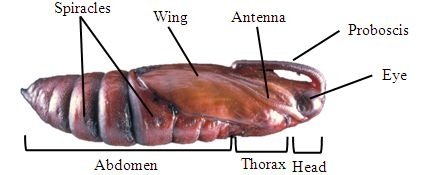
Think of it like a caterpillar retreat. After devouring your plants, hornworms dig underground to take a breather, where they’ll eventually metamorphose into something entirely new. It’s a bit like a nature-themed superhero origin story. In this article, we’ll explore what happens during hornworm pupation, why it’s important, and where these sneaky creatures go while they’re underground.
What Is Pupation?
Pupation is the stage in a caterpillar’s life cycle when it transitions from a larva to a butterfly or moth. During this phase, the caterpillar undergoes a complete transformation, or metamorphosis, and it’s arguably the most fascinating part of its life. You see, insects like hornworms don’t just change on the outside; their entire body is rearranged.
When a hornworm is ready to pupate, it typically finds a safe spot in the soil. This is its way of protecting itself from predators and harsh weather conditions. Inside the pupal casing, the hornworm’s body breaks down and reassembles, preparing it to emerge as a beautiful moth. Imagine it like a sculptor chiseling away at a block of marble to reveal a stunning piece of art hidden within.
Why Do Hornworms Go Underground?
You might be wondering why hornworms choose to dig underground for pupation. The main reason is protection. The underground environment is far safer than being exposed above ground, where birds and other predators are always on the lookout for a quick snack. In the soil, they can maintain a stable temperature and humidity level, which are essential for successful pupation.
Another reason is that the ground provides a perfect habitat for the pupating hornworm. The soil’s composition is often rich in organic material, which helps keep the pupating insect moist and safe as it goes through this delicate process. This is crucial because if the pupal casing dries out too much, it could hinder the metamorphosis, leading to a failed transition.
The Pupation Process
So, what exactly happens during the pupation process? After the hornworm burrows into the ground, it enters a stage called the *prepupa*. At this point, it stops eating and starts to prepare its body for the change. It will usually stay in this phase for a few days before forming a protective casing known as a *pupa* or *chrysalis*.
Inside this casing, the hornworm’s body begins the transformation. It breaks down tissues and reassembles them into the structures necessary for its adult stage. This can take anywhere from a few days to several weeks, depending on various factors like temperature and species. Once this metamorphosis is complete, the new moth will emerge from the pupal casing, ready to take on the world. It’s like waiting for a surprise party to unfold—exciting and full of potential!
How Long Does Pupation Last?
You may be curious about how long hornworms spend underground during their pupation. Generally, this period can last from 1 to 3 weeks, but it varies based on environmental conditions. Warmer temperatures often speed up the process, while cooler conditions can prolong it.
During this time, the caterpillar is basically in a waiting game. It’s important to note that if the conditions are not right—like if it’s too dry or too cold—the pupation might take longer than usual. In some cases, if conditions turn unfavorable, the pupating hornworm might even emerge early, but it will not be fully developed and will likely perish.
Where Do Hornworms Pupate?
When hornworms head underground, they don’t just dig anywhere. They are selective about where they burrow. Typically, you’ll find them seeking out garden beds or rich, loamy soil, often near their host plants. The loose soil allows for easier burrowing, making it an ideal location for pupation.
Interestingly, once they become moths, they will often emerge close to where they buried themselves. This is part of their strategy for survival. By coming back to familiar territory, they can quickly find food sources and mates. You might even spot them fluttering around your garden in the evening, which is when many moths are most active.
The Importance of Pupation
Pupation isn’t just a quirky phase of life for hornworms; it plays a crucial role in the ecosystem. By turning into moths, hornworms contribute to the food chain and the overall health of the environment. Adult moths serve as pollinators, helping to fertilize plants and flowers, which is essential for biodiversity.
Knowing about this life cycle also helps gardeners understand the balance of nature. While hornworms can be pests, they’re also integral players in the ecosystem. Understanding their role can help in making informed decisions about pest control, allowing you to manage your garden in a way that preserves the beneficial aspects of these critters.
Final Thoughts
Hornworm pupation might not be the first thing that comes to mind when you think about gardening, but it’s a fascinating process that highlights the wonders of nature. From the moment they munch on your plants to when they disappear underground, hornworms remind us that transformation is a beautiful, if sometimes messy, part of life.
Next time you encounter a hornworm, you’ll know that beneath the soil, a remarkable change is happening. It’s a cycle of life that connects us all, reminding us that even the smallest creatures have a significant role in the bigger picture. So, as you tend to your garden, take a moment to appreciate the hornworms and their journey underground.
